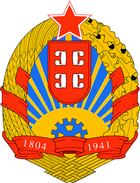Coat of Arms of Serbia
|
|
Grbsr.gif
The Coat of Arms of Serbia, adopted on August 17, 2004, is a replica of the coat of arms of the former Obrenovic dynasty (first adopted in 1882) and features the white bicephalic eagle of the Nemanjić dynasty (which in turn took on the eagle from the Paleologos dynasty of the Byzantine Empire). An ermine cape of the style once worn by kings is featured in the background.
Blazon: The principal field stands for the Serbian State (Gules a double-headed eagle with wings displayed and inverted Argent, langued, beaked, legged and unguled Or, between two fleurs-de-lys of the third in base), while inescutcheon stands for Serbian Nation (Gules a cross Argent between four fire-steels of the same).
The design on the inescutcheon has been used by Serbian states and church since the Middle Ages. It consists of a cross and four firesteels arranged in the quarters around it, all of them facing horizontally outwards. The firesteels were originally used in the Byzantine imperial coat of arms as stylized Greek letters Β and stood for the imperial motto Basileus Basileon Basileuon Basileusin ("King of kings, ruling over kings") in Greek.
The firesteels look like the modern cyrillic letter С, which represents the /s/ sound. They are often rendered as such, especially when the basic design is drawn by hand. They are commonly associated with the slogan Samo sloga Srbina spasava or Само слога Србина спасава ("Only unity saves Serbs").
Although Serbia is now a republic, the new coat of arms also features the crown of the former Serbian monarchy. A crown in this manner usually signifies a monarchial form of government. However in recent years several Eastern European nations have used a crown to signify their royal heritage. Russia and Poland have similarly both restored coat of arms bearing crowns despite being republics.
The socialist coat of arms
After the end of World War II, the new socialist government redesigned the coat of arms, turning it into an example of the arms style used in the Soviet Union and post-war Eastern Europe.The wheat represented peasants and the cogwheel at the bottom represented workers. The red star at the top symbolised communism, the sun with rays represented a new morning. Oak is traditionally a sacred tree for Serbs, hence the oak leaves and acorns. The years 1804 and 1941 on the red ribbon commemorate the First Serbian Uprising and the beginning of National liberation struggle against Axis occupiers in the Second World war.
The coat of arms featured a shield with the traditional Serbian emblem, but since the socialist government officially espoused atheism, the cross, which represents Christianity, was omitted.
The socialist coat of arms remained in official use long after the break-up of socialist Yugoslavia and after the red star was removed from the flag. On August 17, 2004, the parliament of Serbia passed a law which recommends the new coat of arms. There was some controversy, especially about the monarchic symbols in the new coat of arms, and the parliament did not in fact change the description of the coat of arms in the constitution, which would require a larger majority. The old coat of arms thus remains in official use along the new one. This is likely to change in the future.


